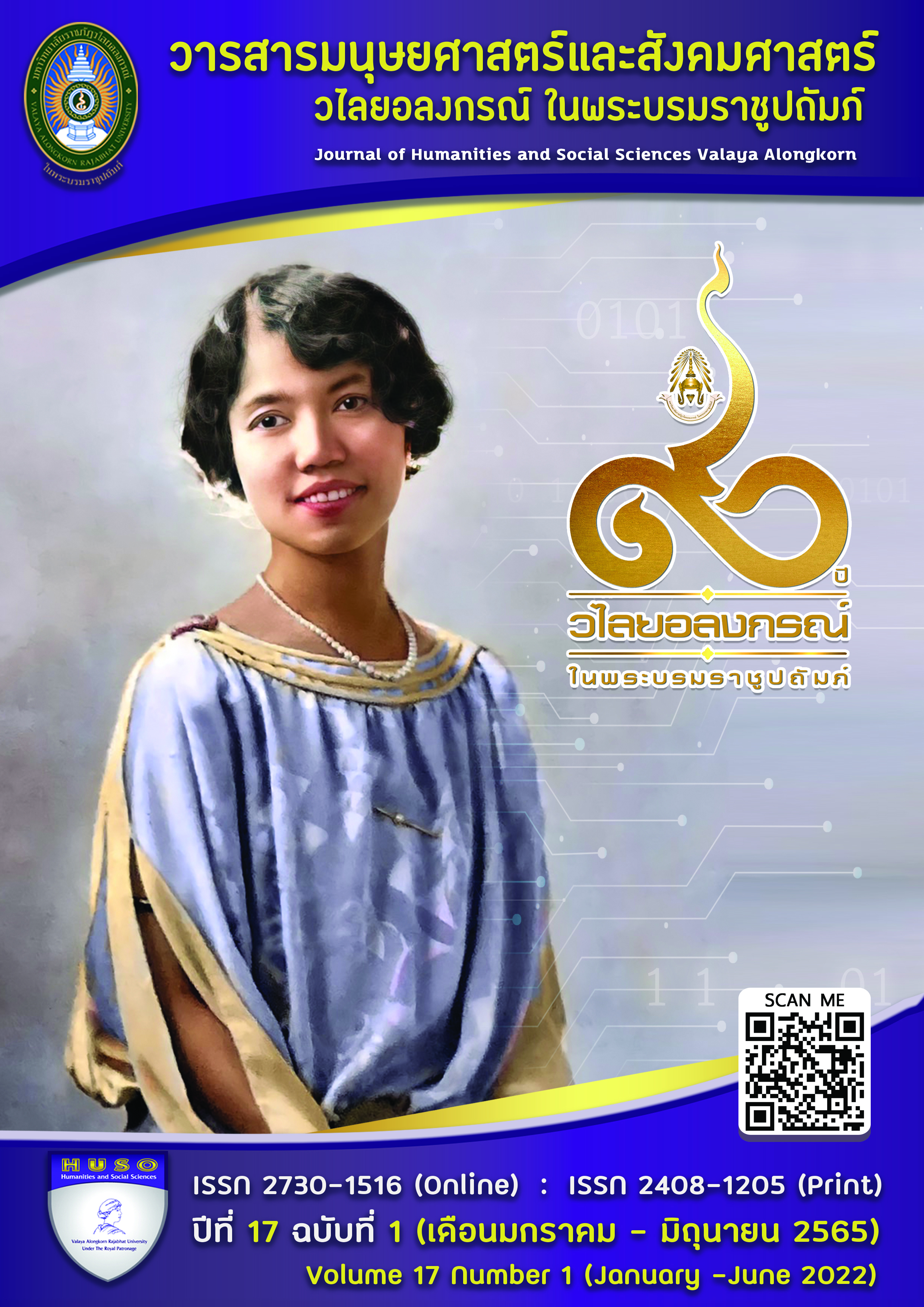HISTORY AND BACKGROUND OF THE MUSLIM COMMUNITY OF KOH YAO NOI
Main Article Content
Abstract
This thesis objective: Study the history and background of the Muslims of Koh Yao Noi This research is qualitative. Research papers and the field using techniques. The research method in ethnographic cultural anthropology for 6 months was based on five data collection processes. Documentary Research, Informal Interview, In-depth Interview, Participant Observation, and Focus Group, analytic induction was used and the analysis was done by typological analysis.
The results of the research revealed that Koh Yao Noi is an old community that existed for more than 200-300 years and is historically related to the city of Thalang. (Phuket) and ethnic diversity Moreover, most of the religious traditions and ceremonies are still based on the practices and judgments of Palaung Ae (1923-1986)
Article Details

This work is licensed under a Creative Commons Attribution-NonCommercial-NoDerivatives 4.0 International License.
ลิขสิทธิ์บทความวิจัยที่ได้รับการตีพิมพ์เผยแพร่ในวารสารมนุษยศาสตร์และสังคมศาสตร์ วไลยอลงกรณ์ ในพระบรมราชูปถัมภ์ ถือเป็นกรรมสิทธิ์ของคณะมนุษยศาสตร์และสังคมศาสตร์ มหาวิทยาลัยราชภัฏวไลยอลงกรณ์ ในพระบรมราชูปถัมภ์ ห้ามนำข้อความทั้งหมดหรือบางส่วนไปพิมพ์ซ้ำ เว้นแต่จะได้รับอนุญาตจากมหาวิทยาลัยเป็นลายลักษณ์อักษร
ความรับผิดชอบ เนื้อหาต้นฉบับที่ปรากฏในวารสารมนุษยศาสตร์และสังคมศาสตร์ วไลยอลงกรณ์ ในพระบรมราชูปถัมภ์ เป็นความรับผิดชอบของผู้นิพนธ์บทความหรือผู้เขียนเอง ทั้งนี้ไม่รวมความผิดพลาดอันเกิดจากเทคนิคการพิมพ์
References
บรรณานุกรม
กรมการปกครอง. (ม.ป.ป.). จำนวนประชากร ระดับตำบลปี พ.ศ. 2563. (ออนไลน์), เข้าถึงได้จาก: https://stat.bora.dopa.go.th/. (2564, 15 ตุลาคม).
กรมพระดำรงราชานุภาพ, พระเจ้าบรมวงศ์เธอ. (2461). พงษาวดารเรื่องเรารบพม่า ครั้งกรุงธน ฯ
แลกรุงเทพ ฯ. ม.ป.ท.: โรงพิมพ์ไทย ถนนรองเมือง.
กรมศิลปากร. (2532). ถลาง ภูเก็ต และชายฝั่งอันดามัน โบราณคดี ประวัติศาสตร์ ชาติพันธ์ และเศรษฐกิจ. กรุงเทพมหานคร: อมรินทร์ พริ้นติ้ง กรุ๊ป.
กศน.ตำบลเกาะยาวน้อย. (ม.ป.ป.). โครงการบ้านหนังสืออัจฉริยะ. (ออนไลน์), เข้าถึงได้จาก: https://sites.google.com/site/phangngateam/home/smys-kul-di. (2564, 3 ตุลาคม).
จักรพงษ์ กลิ่นแก้ว, มานพ วิสุทธิแพทย์ และสุรศักดิ์ จำนงค์สาร. (2563). อุเละห์นบี: ดนตรีสรรเสริญศาสดา
มูฮัมหมัดของมุสลิมนิกายซูฟีย์ในภาคกลางของประเทศไทย. วารสารศิลปกรรมศาสตร์ จุฬาลงกรณ์มหาวิทยาลัย. 2(7) 26-39.
จุมพล เหมะคีรินทร์. (บก.). (ม.ป.ป.). น้ำขึ้น-น้ำลง. สำนักงานปลัดกระทรวงวิทยาศาสตร์และเทคโนโลยี
ภายใต้กิจกรรมการพัฒนาศูนย์ความรู้วิทยาศาสตร์และเทคโนโลยี.
ทยา เตชะเสน. (2558). การศึกษาและอนุรักษ์ “เพลงดีเกีย” ในวัฒนธรรมชาวมุสลิม ตำบลเกาะยาวน้อย อำเภอเกาะยาว จังหวัดพังงา. สำนักงานคณะกรรมการวัฒนธรรมแห่งชาติกระทรวงวัฒนธรรม.
นรรัตน์ บุญกันภัย. (2548). ธรณีวิทยาระวางอำเภอเกาะยาว (4725 III) และระวางเกาะยาวใหญ่ (4724 IV). กรุงเทพ: สำนักธรณีวิทยา กรมทรัพยากรธรณี.
นวพันธุ์ นาคบรรพ์. (2550). แผนยุทธศาสตร์เพื่อการพัฒนาการท่องเที่ยวโดยชุมชนเกาะยาวน้อยจังหวัดพังงา. วิทยานิพนธ์สาขาวิชาวางแผนชุมชน ภาควิชาการวางแผนภาคและเมือง คณะสถาปัตยกรรมศาสตร์ จุฬาลงกรณ์มหาวิทยาลัย.
นิดา ขำเขียว. (2558). เซมา (Sema) วิถีสู่ความจริงสูงสุดของรูมี (Rumi). วารสารราชบัณฑิตยสภา.
(3) 44-67.
ผู้ให้ข้อมูลคนที่ 1 (2563, 23 พฤศจิกายน) ผู้อาวุโสในพื้นที่เกาะยาวน้อย. สัมภาษณ์.
ผู้ให้ข้อมูลคนที่ 2 (2563, 21 ตุลาคม) ปราชญ์ชาวบ้าน. สัมภาษณ์.
ผู้ให้ข้อมูลคนที่ 3 (2564, 19 เมษายน) บาบออับดุลกุดุซ ผู้ดูแล ปอเนาะสันติสุข. สัมภาษณ์.
ภูเก็ตสารสนเทศ. (ม.ป.ป.). ภูเก็ตในอดีต ฉบับพิมพ์โรเนียว. (ออนไลน์), เข้าถึงได้จาก: https://phuketcity.info/. (2564, 6 ตุลาคม).
มุสลิมไทยโพสต์ (ม.ป.ป.). ย้อนอดีต ในหลวง ร.9 ครั้งเสด็จเยือนปอเนาะเกาะยาว. [ออนไลน์], เข้าถึงได้จาก: https://news.muslimthaipost.com/news/29933. (2564, 11 ธันวาคม).
รอง ศยามานนท์. (2511). แถลงงานประวัติศาสตร์เอกสารโบราณคดี. ใน ฉันภิชย์ กระแสสินธุ์ (บ.ก.),
เอกสารเมืองถลาง. 3 (1) 33,97,129. กรุงเทพฯ: สำนักนายกรัฐมนตรี.
ราชบัณฑิตยสถาน. (2546). พจนานุกรมฉบับราชบัณฑิตยสถาน พ.ศ. 2542. กรุงเทพฯ: นานมีบุ๊คส์.
วรรณนะ หนูหมื่น. (2559). คติชาวบ้านเรื่องวาลีในสามจังหวัดชายแดนใต้กับวาลีในนิทานคํากลอนของสุนทรภู่. วารสารปาริชาต มหาวิทยาลัยทักษิณ. 29(2). 194-216.
วิชชุตา ให้เจริญ. (2544). รายงานการวิจัยการจัดการท่องเที่ยวแบบโฮมสเตย์เพื่อการอนุรักษ์สิ่งแวดล้อมและวิถีชีวิตชุมชน กรณีศึกษาชุมชนเกาะยาวน้อย จังหวัดพังงา. กรุงเทพฯ: สำนักงานคณะกรรมการวัฒนธรรมแห่งชาติ กระทรวงศึกษาธิการ.
สามารถ สาเร็ม. (2561). คนแขกลุ่มน้ำทะเลสาบสงขลา. วารสารเมืองโบราณ. 44 (4) 97-109.
สุนัย ราชภัณฑารักษ์. (2517). ภูเก็ต. ม.ป.ท. : ม.ป.พ.
_______________. (2528). ท้าวเทพกระษัตรี. ขอนแก่น: ศิริภัณฑ์ออฟเซ็ท.
REFERENCES
Al-Nawawi, A. Z. (1925). Al-Majmu' Sharh Al- Muhadhdhab. 12 vols. Cairo: Idarat Al-Tiba'a al-Muniriyya.
Aziz, A. H. (2014). A Unified Islamic Calendar Proposal for the World. Middle-East Journal of Scientific Research. 22(1), 115-120.
Bunyakanpai, N. (2005). Geology of Koh Yao District (4725 III) and Tonnage Koh Yao Yai (4724 IV). Bangkok: Bureau of Geology, Department of Mineral Resources, Thailand.
CAPMAS (Central Agency for Public Mobilisation and Statistics). (2009). Statistical Yearbook 2002–2008. Cairo: CAPMAS.
Department of Provincial Administration. (n.d.). The population at the sub-district level for the year 2020. [Online], Available: https://stat.bora.dopa.go.th/. (2021, 15 October).
Haijarean, W. (2001). Homestay Tourism Management for Environmental Conservation and Community Ways: A Case Study of Koh Yao Noi Community, Phang Nga Province. Research report Office of the National Cultural Commission Ministry of Education.
Hamakhirin, J. (Ed.). (n.d.). Tides. Science and Technology Knowledge Centre.
Informant, No. 1. (2020, 23 November) Seniors in Koh Yao Noi area. Interview.
Informant, No. 2. (2020, 21 October) Local Intellectual. Interview.
Informant, No. 3. (2021, 19 April) Babo Abdul Quduz, Santisuk Pondok Executive. Interview.
Joll, C. M. (2014). Thailand's Sufi Networks: New Perspectives on Islamic Diversity and Muslim Marginality. Conference: Transforming Societies: Contestations and Convergences in Asia and the Pacific at: Chiang Mai University.
_______. (2015). Global Islamic Circulations and Sufi Tariqa in Thailand. Conference: Wild Spaces and Islamic Cosmopolitanism in Asia at: Asia Research Institute, National University of Singapore.
Klinkaeo, J., Wisuttipat, M. & Jamnongsarn, S. Olek Nabi: Music ritual of Sufi Muslim in middle part of Thailand. Journal Name: Journal of Fine and Applied Arts, Chulalongkorn University. 2(7), 26-39.
Kumkiew, W. (2015). Sema: The Path Leading to the Ultimate Reality of Rumi. The Journal of the Royal Society of Thailand.
Kuwait Awqaf Public Foundation (KAPF): Annual Report (1997).
Muslimthaipost. (n.d.). Back in the past, King Bhumibol visited the Pondok on Koh Yao. [Online], Available: https://news.muslimthaipost.com/news/29933. (2021, 11 December).
Nakkaban, N. (2007). Strategic plan for community based tourism development of Koh Yao Noi, Phangnga province. Master’s Thesis, University of Chulalongkorn University, Thailand.
Numun, W. (2016). Folk Myths of Walee in Three Southern Border Provinces and Walee in SunthornPhu’s Poetry Tale. Parichart Journal, Thaksin University. 29(2), 194-216.
Phuket Information. (n.d.). Phuket in the past, mimeograph edition. [Online], Available: https://phuketcity.info/. (2021, 6 October).
Rajanupab, K. P. (1918). Annals, we are at war with Burma, the era of Krungthon and Bangkok. n.p.; Rongpimthai Rongmueng road.
Rajphatharuk, S. (1974). Phuket. n.p.
_____________. (1985). Thao Thepkasattri. Khon Kaen: Siriphan.
Royal Institute. (2003). The Royal Institute's Dictionary, 1999. Bangkok: Nanmeebooks.
Saeed, A. (2007). Islamic Thought: An Introduction. London and New York: Routledge.
Sarim, S. (2018). Khonkheg, Songkhla Lake. Muang boran journal. 44(4), 97-109.
Sasakul, C. (2019). Sufism in Thailand: A study of impact on The Thai Muslims. A thesis submitted for the award of the degree of Doctor of Philosophy in Islamic Studies at Aligarh Muslim University.
Sayamanon, R. (1968). Statement on the history of archeology documents in Krasasin, C. (Ed.). Muang Thalang Documents. 3(1), 33, 97, 129. Bangkok: Office of the Prime Minister.
Taychasay, T. (2015). A Study and Conservation of “Di-kear Song” in Muslim Culture in Tambon Ko-Yao Noi, Amphoe Ko-Yao, Phang-Nga Province”. Cultural and Cultural Office, Ministry of Culture (Thailand).
The Fine Arts Department. (1989). Thalang, Phuket, and Andaman Coast, Archaeology, History, Ethnic and Economy. Bangkok: Amarin printing group.


